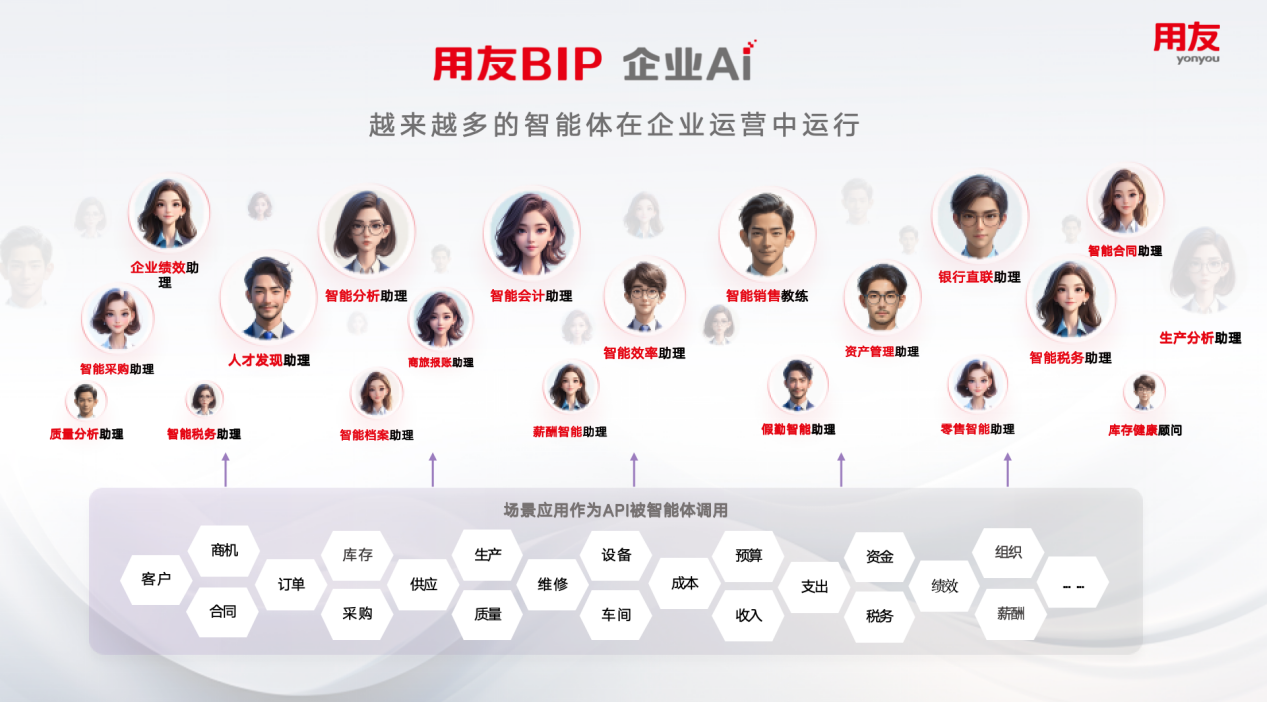2025: The Optimal Era for Enterprises to Embrace Agent Technology
![]() 06/10 2025
06/10 2025
![]() 617
617
Text | Ling Bell
Today, the desktops of employees are adorned with numerous Agent applications, which companies affectionately refer to as 'colleagues', 'assistants', or 'partners'. As enterprise AI implementations advance, the 'employment' of agents has become ubiquitous, with a myriad of vendors successively launching innovative agent products.
In March of this year, Yonyou upgraded its flagship enterprise AI product, Yonyou BIP's 'ZhiYou', positioning it as the 'Enterprise Intelligent Chief Supervisor'. This upgrade coordinates enterprise-level agents, fosters a novel mode of intelligent scheduling and collaboration, and propels the large-scale operation of agents. Subsequently, Kingdee also unveiled its comprehensively upgraded SkyAgent platform 2.0 along with five agents, spanning diverse business areas such as financial report analysis, recruitment, business travel, enterprise knowledge management, and enterprise data governance.
These actions have laid the groundwork for the prevailing approach to enterprise AI implementation this year—leveraging agents as the conduit for AI applications and deepening industry scenarios.
The Optimal Era for Enterprises to Embrace Agent Technology
Historically, discussions surrounding enterprise AI implementation often oscillated between two extremes: infrastructure-centric architecture construction and model deployment, or remaining at the tool level for report generation, data query, etc. Both approaches faced a critical question: how can AI be seamlessly integrated into a company's operations and business development? The result was often direct: enterprise AI was implemented, but frontline employees found it unusable or cumbersome, leading to a fragmented landscape.
In the realm of enterprise AI applications, agents emerge as a more direct, effective, and holistic carrier. With years of exploration and accumulation, the present moment may indeed be the optimal era for enterprises to adopt agents.
1. Automated and Closed-Loop Disassembly of Business Processes and Logic
From today's perspective, this point is relatively straightforward. Yonyou's Business Travel Expense Assistant, for instance, has achieved full-process automation. Employees submit business travel applications through natural language interaction, and the system automatically matches travel standards, recommends itineraries, and completes bookings. Consumption data is directly integrated with the financial system, with an AI review engine performing real-time compliance checks and automatically archiving electronic invoices. Similarly, Kingdee's newly launched Recruitment Agent and Business Travel Agent also strive to automate and close the loop of these business processes, providing employees with proactive intelligent experiences.
Prior to this, enterprise AI experiences were largely fragmented. Business travel, encompassing itinerary planning and reimbursement, was managed by two separate systems, requiring employees to manually link them by saving valid materials like receipts and vouchers. For recruitment-related tasks like resume recognition, screening, and interview scheduling, although they belonged to the same system, the involved people, times, locations, and processes were too complex and could only be coordinated and advanced by humans.

Currently, Yonyou and Kingdee are meticulously disassembling various business processes and logic, specifying AI's role in each step and the enterprise systems that need coordination for business development. This gradual integration into agents creates a highly consistent intelligent service, marking a significant departure from past enterprise AI implementations.
2. Fundamentally Reconstructed Human-Machine Interaction Logic
Dialogue understanding is a cornerstone of agents and the most intuitive experience perception of enterprise AI at its current iteration stage. For instance, Yonyou's ChatBI (Intelligent Question Answering) can execute complex data analysis and visual presentation through simple chat. Similarly, Kingdee emphasizes the natural language dialogue experience in launching ChatBI, continuously refining the user experience. These represent the direct interactive feedback brought about by enterprise AI entering the agent era.
However, the deeper significance lies in enterprise AI's profound understanding of a company's business, with its overall intelligent recognition, understanding, decision-making, and execution capabilities undergoing a systematic upgrade. Behind Yonyou's ChatBI lies the bridging of multi-source data barriers, enabling efficient cross-departmental and cross-system collaboration and sharing. For example, Yonyou's Smart Contract Assistant's essence in intelligent recognition of contract information stems from its preset contract rules, with 67 key information fields based on industry know-how. Thus, after uploading relevant contract documents, the AI agent can accurately complete identification and screening.

From understanding business logic to defining interaction logic, agents' maturity is evident. This progress will be a vital safeguard for the rapid implementation of enterprise AI, with AI redefining the way it interacts with employees rather than employees learning and adapting. The product iterations of Yonyou and Kingdee increasingly reflect this widening gap.
3. Result-Oriented Agents Prioritizing Enterprise Experience
This is a nuanced change. The proliferation of agents is steering enterprise AI towards a path closer to business scenarios and employee users. Looking back, deploying large models, scaling up model parameters, or following trends for AIGC and generative AI applications unrelated to business seem to deviate from the genuine demands of enterprise AI.
Kingdee has already proposed the transformation from the SaaS model to the RaaS model to the market. Put simply, enterprise AI services are charged based on results, such as its Business Travel Agent being billed per business trip. This model, directly tied to business outcomes, aligns more closely with enterprise users' interests and represents a key distinction as enterprise AI enters the agent era, potentially catalyzing substantial industry changes.
In summary, focusing on agents, the implementation of enterprise AI becomes more direct, results-driven, business-understanding, and user-facilitating, eschewing unrealistic or grandiose pursuits. This trend has already manifested in the concentrated explosion of products launched in the first half of this year, heralding the peak period for enterprises to adopt agents.
The Second Half of 2025: Agents' Tremendous Potential
From an industry perspective, Yonyou and Kingdee's successive releases of agent products are significant signals. Enterprise AI implementation will accelerate into the agent era, led by enterprise service providers, with the potential for large-scale adoption hinging on bringing enterprises and employees together. Addressing many challenges during this period necessitates considering industry scenarios and business processes.
On one hand, Yonyou and Kingdee have recognized that agents' breakthrough lies in deeply excavating and redefining industry scenarios and business processes. However, given the complexity of various industries' business processes, it's challenging for enterprise service providers alone to accomplish this. The crux is that the entity leading the AI-driven reconstruction of business processes isn't a direct participant in the business.
For common business scenarios like recruitment and business travel, enterprise service providers can still disassemble processes and redefine AI experiences. However, for areas like finance, taking Kingdee's financial report analysis agent 'Golden Key Financial Report' as an example, while it provides in-depth analysis of company financial reports, it's unclear who specifically uses this function. Are they non-financial professionals? Do they genuinely need this service? In fact, once functions involving professional domains are involved, subjectivity becomes less clear and cannot be as straightforward as common business processes like recruitment and business travel.
Kingdee's launch of the SkyAgent 2.0 platform seems to address this, throwing the problem back to enterprises and employees themselves by offering full-link development capabilities from scenario template design, agent construction, to task flow orchestration. This allows actual business participants and leaders to construct suitable agents. While the concept is sound, industry pain points persist, and agents' proliferation will still rely on enterprises' and employees' acceptance and innovation capabilities towards enterprise AI.
On the other hand, the long-chain planning and multi-module coordination of complex tasks remain daunting. The essence of this challenge stems from continued unclear subjectivity, impacting the system's ability to clarify roles. Continuing with the 'Golden Key Financial Report' example, compared to the Business Travel Agent and Recruitment Agent, which can outline a relatively complete application path, this function fails to provide enterprises with systematic application insights, such as why financial report analysis is needed, where the analyzed data and conclusions are used, and how it empowers enterprise operations. 'Golden Key Financial Report' has yet to answer these questions.
In this process, inevitably, the entire agent's business planning and module coordination remain fragmented and independent, failing to interconnect with other modules and business departments, resulting in a lack of systematicness. Some exhibit stronger systematic performance, like the Business Travel Agent directly linking with the financial system to automatically review and archive relevant reimbursement data and vouchers, or the Recruitment Agent connecting with business departments to complete JD writing and candidate screening based on business needs.
The existence of these issues will continue to impede enterprise AI implementation. Either enterprises or employees themselves can proactively develop the platforms provided by Yonyou and Kingdee, but whether they are open for industry-wide use remains to be seen. Perhaps enterprise service providers must continue exploring business models for agent development and promotion. Alternatively, enterprise service providers like Yonyou and Kingdee can meticulously tackle large and complex enterprise business scenarios one by one, forming their own core competitive advantages, such as Kingdee and Yonyou's strengths in the financial domain, and continue specializing in agent applications within a certain field to achieve industry-leading performance.
Written at the End
Regardless of the aspect driving agents' proliferation, this year will be the optimal era for enterprises to embrace agent technology. Agents have the potential to become the mainstream form of enterprise AI, and early adopters enjoy a first-mover advantage—because the core essence of competition remains unchanged. Whoever can deeply cultivate a specific industry scenario or business process will seize the initiative in the enterprise service market.
From 'Ling Bell's' perspective, whether it's leading vendors like Yonyou and Kingdee or other small and medium-sized service providers, they should fortify their areas of expertise and encapsulate them into agents in the AI era to serve enterprises. This logic mirrors traditional enterprise software services, and those entering this year are often better positioned to organically integrate industry know-how and AI capabilities before agents' proliferation.
In the future, it may not be a scenario of a single dominant all-round service. Perhaps some excel in recruitment scenarios, others in contract scenarios, financial scenarios, etc. When enterprises require them, they can unify each specialized agent based on open interfaces and utilize them in their business operations. Therefore, the specialized and in-depth excavation of business scenarios will be the cardinal principle for enterprise AI implementation.
*All images in this article are sourced from the internet







